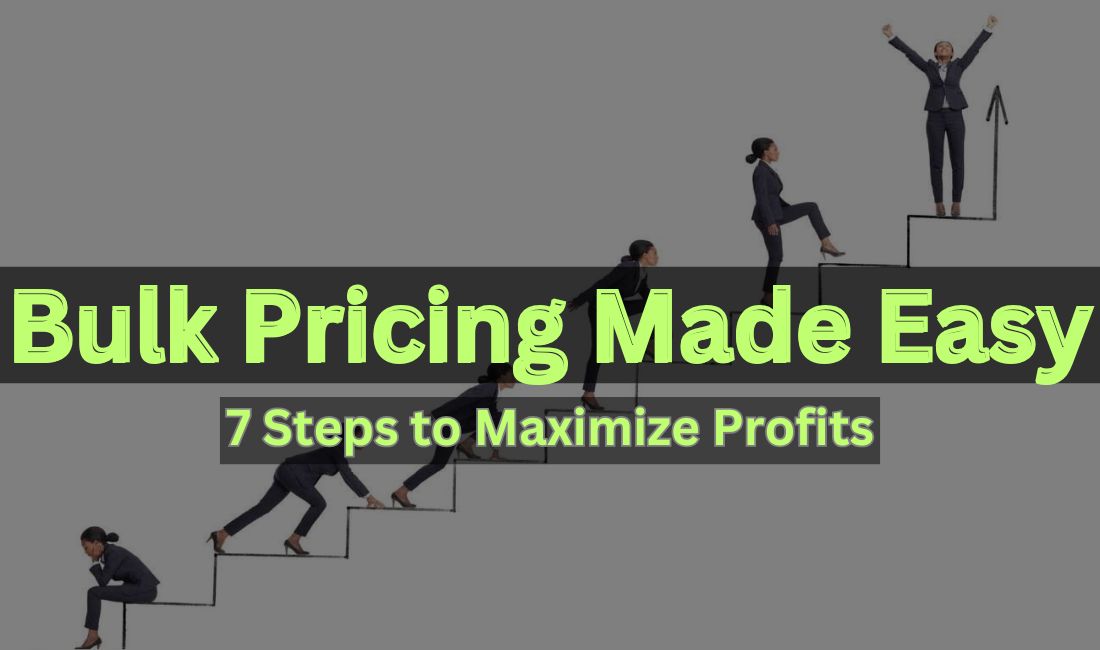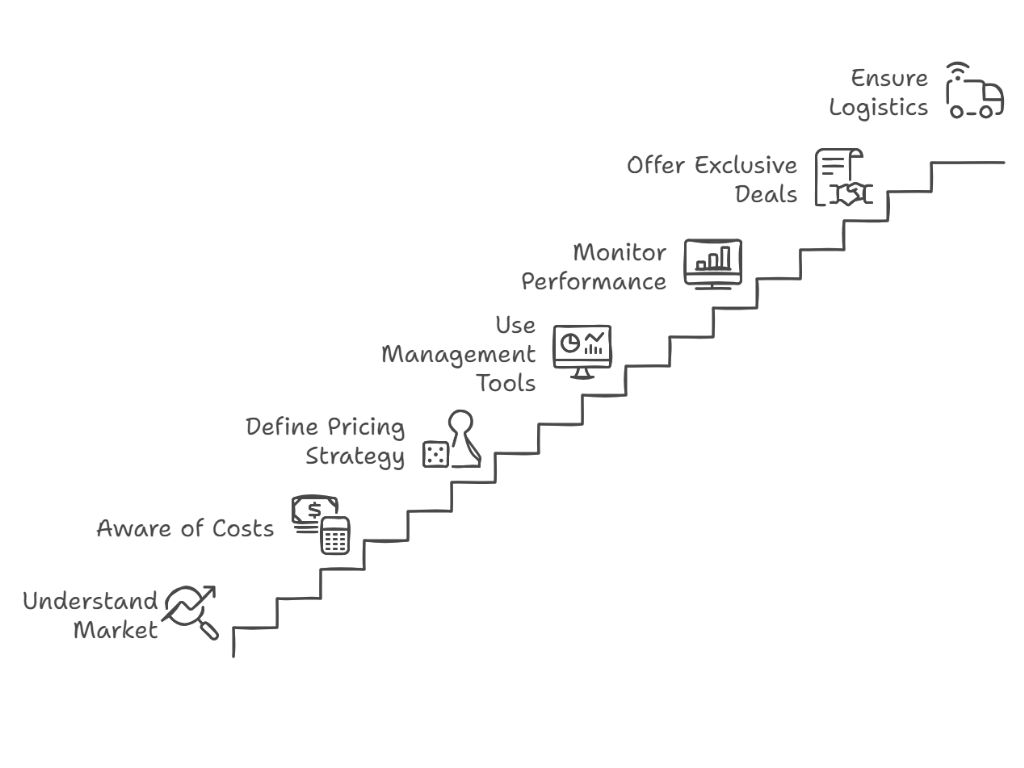
At a compound annual growth rate (CAGR) of 7.0%, the worldwide wholesale market expanded from $45,672.51 billion in 2022 to $48,883.25 billion in 2023. Bulk pricing is a powerful strategy for driving sales and increasing customer loyalty. It offers a unique opportunity to incentivize larger purchases, streamline operations, and enhance profitability. But to truly unlock its potential, it’s essential to understand not just the mechanics but also the psychology that drives customers to buy more.
In this article, we’ll break down what bulk pricing is, explore the psychology behind bulk buying, and show you how to implement it in your business. We’ll also share key strategies, how to overcome challenges, and tips for marketing your bulk offers effectively. Plus, we’ll highlight the benefits of bulk pricing, especially for B2B businesses. Whether you’re just starting or looking to optimize, this guide will give you the tools to use bulk pricing for growth and success. Let’s get started!
Table of Contents
What is Bulk Pricing?
Bulk pricing, also known as quantity discounts, is a pricing strategy used to incentivize customers to purchase larger product quantities. This strategy is often used for products with a low unit cost, such as wholesale goods or bulk items. The idea behind the pricing strategy is that customers will save money on the overall purchase by purchasing more items.
For example, you may offer a bulk discount of 10% for purchasing 10 or more of a product. This can be an effective way to increase sales and move inventory for you while providing a perceived value for the customer.
Bulk pricing can also target specific customer segments like businesses or wholesalers. With the pricing approach, retailers can attract customers looking to purchase large quantities of a product at a discounted price.
In e-commerce, bulk pricing can be implemented through coupon codes or special promotions. Retailers can also use dynamic pricing software to automatically adjust prices based on the quantity of items in a customer’s cart.
The Psychology Behind Bulk Buying
The thing that attracts retailers most in bulk purchasing is the discounts. It reduces the cost per item compared to purchasing smaller quantities. Lower unit costs enable the price to be competitive while maintaining healthy margins. That’s why retailers usually buy their products in bulk.
Another reason is consistent stock availability. Bulk buying ensures that retailers can meet customer demand without delays. They can stock up in advance for high-demand periods if they buy products or materials in large quantities.
It also costs less. Shipping large orders in one go often reduces transaction costs compared to multiple smaller shipments. It minimizes the carbon footprint, aligning with eco-conscious values.
Last but not least, bulk purchases lock in prices and protect retailers from market fluctuations or sudden supplier price increases. Buying in bulk during periods of rising prices helps maintain profit margins.
As a wholesaler, you can target retailers appropriately if you understand retailers’ psychological reasons for choosing bulk buying. Your bulk pricing can be more suitable and more attractive.
How to Implement Bulk Prices in Your Business

- Understand Your Market And Customers
- Be Aware of Your Costs
- Define Your Pricing Strategy
- Use Tools or Software to Manage Pricing
- Monitor Performance And Adjust as Needed
- Offer Exclusive Bulk Deals to High-Value Clients
- Ensure Smooth Logistics And Operations
Step#1 Understand Your Market And Customers
Spend some time getting to know your market before diving into bulk pricing. Your clients consist of who? What purchasing patterns do they exhibit? Are they wholesale giants or little companies? Separating your clients can help you design reasonable pricing ranges for every group and inspire bigger orders.
Step#2 Be Aware of Your Costs
You must know your expenses inside and outside if you want your pricing to stay lucrative. This covers shipping, packaging, manufacturing charges, and any other overheads. Calculating your margins will enable you to determine the proper price without running losses.
Step#3 Define Your Pricing Strategy
It’s time now to choose your method of grouping your bulk prices. Will you provide quantity-based tiered discounts? Alternatively, will you give spend-based discounts as the priority? Ensure your chosen approach is appealing, transparent, and straightforward to your clients.
Step#4 Use Tools Or Software To Manage Pricing
Handly managing pricing can be challenging. Invest in tools or programs that watch consumer orders, automatically change pricing, and provide performance analysis. Significantly, when your company expands, this might save time and help lower mistakes. There are a lot of bulk pricing apps available in Shopify. You can use them to make things easier.
Step#5 Monitor Performance And Adjust as Needed
Track vital statistics once your pricing is online, including average order value and customer comments. Are consumers making bulk purchases? Are your earnings targets met? Based on this input, modify your approach or price to help to maintain things under control.
Step#6 Offer Exclusive Bulk Deals to High-Value Clients
Think about running special promotions or customized bulk discounts for your regular clients. This promotes loyalty and creates long-term partnerships more likely to bring returning business.
Step#7 Ensure Smooth Logistics And Operations
Assure your logistics are geared up to manage big orders at the minute. Maintaining things running as mass orders rise depends mostly on effective inventory control, delivery procedures, and customer service. It also improves customer experiences.
Key Strategies For Implementing Bulk Pricing
Every kind of bulk pricing has advantages and fits various company structures. Choose the one that most fits your objectives and client expectations.
- Tiered Prices
- Volume-Based Pricing
- Bundle Prices
- Spend-Based Pricing
- Subscription or Membership-Based Mass Pricing
Strategy#1 Tiered Prices
Discounts in tiered pricing rise as purchase volume rises. For instance, purchasing 10–20 units might provide a 5% discount; buying 50+ units gets a 20% discount. This approach balances profitability and volume so consumers purchase more for better offers.
Strategy#2 Volume-Based Pricing
Once a given amount is reached, volume-based pricing treats all things bought using the same discount rate. Purchasing 100 units can, for example, reduce the cost per unit for the whole order. This simple approach draws consumers looking for significant savings on large purchases.
Strategy#3 Bundle Prices
Many items are arranged here and sold at a reduced price. For instance, a bundle of three complimentary things can cost less than if purchased separately. This helps to boost the average order value and cross-selling.
Strategy#4 Spend-Based Pricing
Spend-based pricing provides discounts when consumers achieve a particular order value without depending on volume to base discounts. “Spend $500 and get $50 off,” for example. This motivates consumers to load more products into their carts to cross the threshold.
Strategy#5 Subscription or Membership-Based Mass Pricing
Under this approach, clients pay a membership fee or subscribe for exclusive group discounts. It guarantees a constant income for the company and promotes client loyalty.
Turn Challenges Into Revenue Growth Opportunities
- Risk of Losing Profits With Poorly Planned Discounts.
- Managing Customer Expectations.
- Inventory Issues
Challenge 1: Risk of Losing Profits with Poorly Planned Discounts
Poorly planned discounts can cut into your revenues. It is one of the main issues with bulk pricing.
Solution: Calculate wholesale price with cost analysis instruments. Profit margin calculators or dynamic pricing systems can guarantee your discounts stay competitive without sacrificing profitability.
Challenge 2: Managing Customer Expectations
Discontent consumers result from misinterpretation of discount terms. Make sure all bulk price terms are stated to help to avoid this.
Solution: Show clearly on product pages display pricing tiers. Provide thorough explanations in your email marketing, order confirmations, and FAQs. Good communication lessens uncertainty and fosters trust.
Challenge 3: Inventory Issues
If not adequately controlled, bulk pricing may cause overstocking or stockouts, taxing your inventory.
Solution: The answer is putting strong inventory control systems into use. These instruments guarantee you always have the correct products to satisfy consumer needs, track inventory levels, and help project demand.
These difficulties can be resolved quickly with the correct tactics, guaranteeing a successful pricing model.
Promote Your Bulk Price Offers
Attracting clients and increasing sales depend on effectively promoting your bulk price offers. First, show your product pages your bulk pricing levels clearly and conspicuously. Using tables or dropdown options guarantees consumers can rapidly see how much they save when they increase purchases. To make it simple for possible consumers to find deals in one location, you can also design a special pricing page highlighting bulk discounts on your most sold products.
Then, concentrate on customization. Send your B2B customers custom pricing offers via email or through their dashboards. Emphasize the advantages they will get—such as better deals or higher savings.
Do not overlook loyalty programs. Use email campaigns to let current customers know about fresh promotions. Giving returning clients further discounts fosters confidence and increases long-term revenues. Put banners on your website and perform focused social media campaigns to improve your profile.
Benefits of Bulk Pricing In B2B Markets
Bulk pricing motivates consumers to make one large purchase to qualify for discounts. Larger orders follow from this directly, which speeds up inventory movement and helps to lower storage expenses.
Providing pleasing bulk discounts demonstrates to clients the value of their business. It builds faith and motivates returning visits. It makes one-time purchases to devoted customers.
Customers who buy in volume pay more upfront. This preserves consistent cash flow. Expenses like operational costs and inventory replenishing are within your easy control.
By helping slow-moving inventory to be cleared, it can liberate warehouse capacity for more recent goods. This is a quick approach to prevent related holding costs and overstock problems.
It also increases your income and operational efficiency while helping your consumers save money—a win-win situation. Any wholesaler trying to expand would find this approach wise.
Conclusion
Bulk pricing is an effective method for increasing sales, customer loyalty, and market presence. Knowing consumer psychology and using well-defined price structures will help you increase orders and expand your company. Overcoming obstacles, including business risks and inventory problems, creates chances for expansion. In B2B markets, practical marketing and communication assist in highlighting your value. The correct strategy can mainly drive profitability and long-term success.
Bulk Pricing FAQ
What is Bulk Price?
Bulk price is a pricing strategy where customers receive a discount for purchasing larger quantities of a product. This approach encourages higher volume purchases by offering reduced prices per unit as the quantity increases.
How Does Tiered Bulk Pricing Work?
In tiered pricing, discounts are applied based on predefined quantity ranges. For example, buying 10-20 units might offer a 5% discount, while purchasing 50 or more units could provide a 20% discount. This method incentivizes customers to buy more to achieve greater savings.
How Can I Set up Bulk Pricing For a Single Product in Shopify?
Shopify allows you to set up quantity rules and volume pricing for individual products. You can add up to 10 price breaks per variant. This can be done in the Catalogs section of your Shopify admin or by importing a CSV file. You can also use a third-party app.
Are There Apps Available to Manage Bulk Pricing on Shopify?
Yes, there are several third-party apps designed to help you manage bulk pricing and volume discounts. These apps offer features like tiered pricing, customer-specific discounts, and more. You can explore the Shopify App Store to find one that suits your needs.
